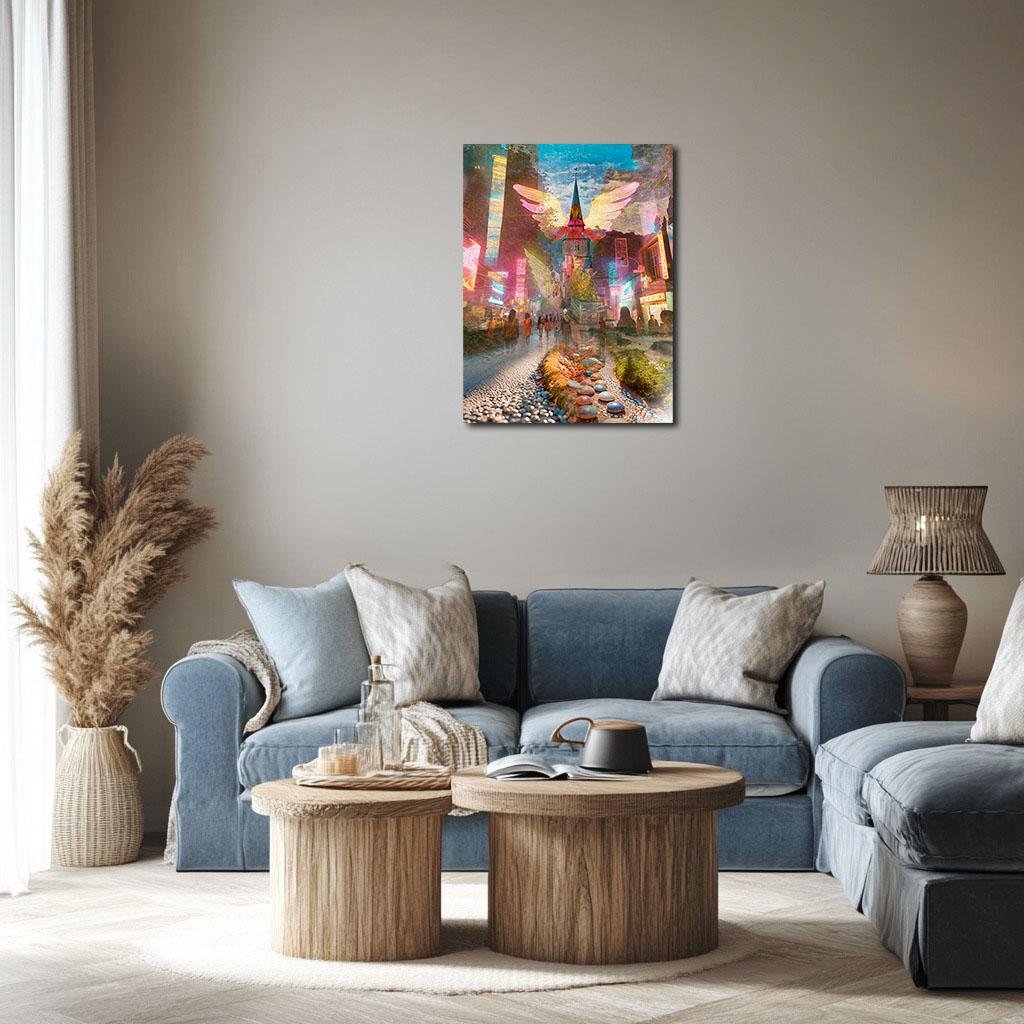The Passage of Light: Sainte-Adresse Reimagined in Neon Grace
The Passage of Light: Sainte-Adresse Reimagined in Neon Grace transforms Monet’s quiet French street into a surreal urban avenue of light and spirit. A hovering angel watches over glowing city paths, where each step activates a jeweled journey. This conceptual urban landscape blends tradition and futurism, offering a meditation on movement, grace, and the sacred beauty found within the pulse of modern life.
Please see Below for Details…
Hotline Order:
Mon - Fri: 07AM - 06PM
404-872-4663
Claude Monet’s Street in Sainte-Adresse , painted in the 1860s, quietly captures the tranquility of a seaside town where figures pass through sunlit streets, shadowed by steep rooftops and the sloping rhythm of nature’s incline. It is a painting of place, of human scale within architectural humility, and of the soft cadence of daily movement. In this conceptual reinterpretation, titled The Passage of Light: Sainte-Adresse Reimagined in Neon Grace , that modest provincial street expands into an illuminated dreamscape—where urban fluorescence meets spiritual intervention, and the cobbled path becomes a jeweled thread pulling memory and divinity into a single stream of motion.
At the center of the piece, the steeple of a church rises—tall, grounded, quietly luminous. But its structure is now bathed in kaleidoscopic light, its stone softened by digital glow, its tower framed not by sky alone, but by cityscape, windows, and the gentle shimmer of glass façades. The scene has shifted. No longer a sleepy French street, this is a nocturnal avenue pulsing with neon and the hum of the modern. Yet the presence of Monet’s original world is not gone—it has been absorbed. The architecture stands firm. The angles remain familiar. But the palette and pace have transformed into something living, something electric.
Around the church and into the streets below, figures walk—blurred silhouettes and radiant outlines. Some move toward the center, others wander toward the glowing edges of the city. They are not rushing. Their pace is contemplative. Their path, though paved in stone, is not static. It shimmers. The road itself curves toward the foreground, composed of pebbles and gemstones, forming a kind of sacred current beneath their feet. It is as if each step activates light, sound, memory. The street becomes not a place of passage but a place of transformation.
Above them all, an angel hovers—not carved in stone, not painted in oil, but formed of radiant color, transparent layers, and soft motion. Her wings stretch outward in hues of peach, rose, and firelight gold, blending into the sky like watercolor catching sunlight. She is not heavenly in grandeur, but intimate in presence. She belongs not only to the cathedral behind her but to the city itself. Her gaze is downward, her posture protective. She is the spirit of guidance—not a watcher from afar, but a presence within. She is not part of mythology. She is part of the streetlight.
Behind her, the sky transitions from Monet’s original cool daylight into a layered sunset—half urban dusk, half celestial canvas. The buildings glow with signage and digital reflections, but behind their façades, the texture of history peeks through—faint brushwork, fragments of painted windows, muted tones from another era. These overlays suggest a city built not only with stone and steel, but with the residue of memory. The urban lights do not erase the past. They illuminate it.
On the far edges of the image, soft trees lean inward, blending with shopfronts and digital screens. Nature has not disappeared. It has evolved into texture, into shadow. Moss climbs beneath the pebbles. Ferns unfurl near sidewalk cracks. Light dances across leaves and wires alike. The organic and the synthetic cohabitate, not as tension, but as rhythm.
Color here is essential. Magentas, cyans, tangerines, and soft silvers flood the scene, wrapping the familiar in wonder. These hues speak to dream, to emotion, to longing—not rooted in realism, but in internal perception. The cobblestone path becomes a rainbow stream. The city glows like a waking memory. The angel’s wings pull warmth into the night, softening the artificial with compassion.
As the artist, I imagined this reinterpretation as a blend of pilgrimage and presence. Monet’s street was once a quiet route to the sea. Here, it becomes a current of people walking not to escape, but to see. The angel is not a miracle. She is the echo of every kindness, every pause, every glance upward amid the speed of passing lights. The stones underfoot become jewels because every step is sacred when noticed.
The Passage of Light is a vision of continuity. Of how the sacred can exist in the rush of the modern. Of how color becomes compass. Of how the ghosts of quiet towns remain in the cracks of cities, whispering grace through the wires. This is no longer just Sainte-Adresse. It is every street walked with attention. It is every night lit not only by neon, but by memory and presence.
Add your review
Your email address will not be published. Required fields are marked *
Please login to write review!
Looks like there are no reviews yet.








